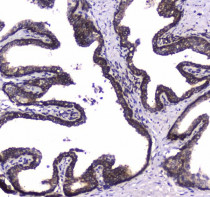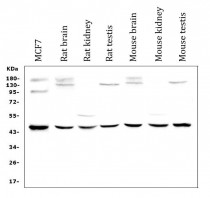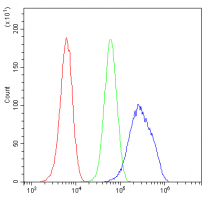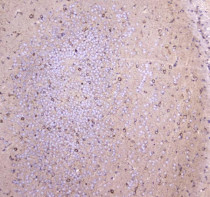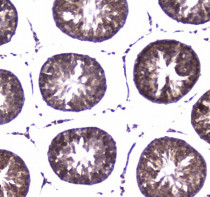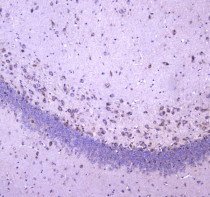ARG43038
anti-WWOX antibody
anti-WWOX antibody for Flow cytometry,IHC-Formalin-fixed paraffin-embedded sections,Western blot and Human,Mouse,Rat
Overview
| Product Description | Rabbit Polyclonal antibody recognizes WWOX |
|---|---|
| Tested Reactivity | Hu, Ms, Rat |
| Tested Application | FACS, IHC-P, WB |
| Host | Rabbit |
| Clonality | Polyclonal |
| Isotype | IgG |
| Target Name | WWOX |
| Antigen Species | Human |
| Immunogen | Recombinant protein corresponding to aa. M1-D245 of Human WWOX. |
| Conjugation | Un-conjugated |
| Alternate Names | D16S432E; EC 1.1.1.-; FRA16D; FOR; WOX1; EIEE28; WW domain-containing oxidoreductase; Short chain dehydrogenase/reductase family 41C member 1; SCAR12; Fragile site FRA16D oxidoreductase; HHCMA56; PRO0128; SDR41C1 |
Application Instructions
| Application Suggestion |
|
||||||||
|---|---|---|---|---|---|---|---|---|---|
| Application Note | IHC-P: Antigen Retrieval: Heat mediation was performed in Citrate buffer (pH 6.0) for 20 min. * The dilutions indicate recommended starting dilutions and the optimal dilutions or concentrations should be determined by the scientist. |
Properties
| Form | Liquid |
|---|---|
| Purification | Affinity purification with immunogen. |
| Buffer | 0.2% Na2HPO4, 0.9% NaCl, 0.05% Sodium azide and 4% Trehalose. |
| Preservative | 0.05% Sodium azide |
| Stabilizer | 4% Trehalose |
| Concentration | 0.5 mg/ml |
| Storage Instruction | For continuous use, store undiluted antibody at 2-8°C for up to a week. For long-term storage, aliquot and store at -20°C or below. Storage in frost free freezers is not recommended. Avoid repeated freeze/thaw cycles. Suggest spin the vial prior to opening. The antibody solution should be gently mixed before use. |
| Note | For laboratory research only, not for drug, diagnostic or other use. |
Bioinformation
| Database Links |
Swiss-port # Q91WL8 Mouse WW domain-containing oxidoreductase Swiss-port # Q9NZC7 Human WW domain-containing oxidoreductase |
|---|---|
| Gene Symbol | WWOX |
| Gene Full Name | WW domain containing oxidoreductase |
| Background | This gene encodes a member of the short-chain dehydrogenases/reductases (SDR) protein family. This gene spans the FRA16D common chromosomal fragile site and appears to function as a tumor suppressor gene. Expression of the encoded protein is able to induce apoptosis, while defects in this gene are associated with multiple types of cancer. Disruption of this gene is also associated with autosomal recessive spinocerebellar ataxia 12. Disruption of a similar gene in mouse results in impaired steroidogenesis, additionally suggesting a metabolic function for the protein. Alternative splicing results in multiple transcript variants. [provided by RefSeq, May 2014] |
| Function | Putative oxidoreductase. Acts as a tumor suppressor and plays a role in apoptosis. Required for normal bone development (By similarity). May function synergistically with p53/TP53 to control genotoxic stress-induced cell death. Plays a role in TGFB1 signaling and TGFB1-mediated cell death. May also play a role in tumor necrosis factor (TNF)-mediated cell death. Inhibits Wnt signaling, probably by sequestering DVL2 in the cytoplasm. [UniProt] |
| Cellular Localization | Cytoplasm. Nucleus. Mitochondrion. Golgi apparatus. Note=Partially localizes to the mitochondria (PubMed:14695174). Translocates to the nucleus upon genotoxic stress or TNF stimulation (By similarity). Translocates to the nucleus in response to TGFB1 (PubMed:19366691). Isoform 5 and isoform 6 may localize in the nucleus. [UniProt] |
| Calculated MW | 47 kDa |
| PTM | Phosphorylated upon genotoxic stress. Phosphorylation of Tyr-33 regulates interaction with TP53, TP73 and MAPK8. May also regulate proapoptotic activity. Phosphorylation by TNK2 is associated with polyubiquitination and degradation. Ubiquitinated when phosphorylated by TNK2, leading to its degradation. [UniProt] |
Images (6) Click the Picture to Zoom In
-
ARG43038 anti-WWOX antibody IHC-P image
Immunohistochemistry: Paraffin-embedded Human prostatic cancer tissue. Antigen Retrieval: Heat mediation was performed in Citrate buffer (pH 6.0) for 20 min. The tissue section was blocked with 10% goat serum. The tissue section was then stained with ARG43038 anti-WWOX antibody at 1 µg/ml dilution, overnight at 4°C.
-
ARG43038 anti-WWOX antibody WB image
Western blot: 50 µg of sample under reducing conditions. MCF7, Rat brain, Rat kidney, Rat testis, Mouse brain, Mouse kidney and Mouse testis lysates stained with ARG43038 anti-WWOX antibody at 0.5 µg/ml dilution, overnight at 4°C.
-
ARG43038 anti-WWOX antibody FACS image
Flow Cytometry: U2OS cells were blocked with 10% normal goat serum and then stained with ARG43038 anti-WWOX antibody (blue) at 1 µg/10^6 cells for 30 min at 20°C, followed by incubation with DyLight®488 labelled secondary antibody. Isotype control antibody (green) was rabbit IgG (1 µg/10^6 cells) used under the same conditions. Unlabelled sample (red) was also used as a control.
-
ARG43038 anti-WWOX antibody IHC-P image
Immunohistochemistry: Paraffin-embedded Mouse brain tissue. Antigen Retrieval: Heat mediation was performed in Citrate buffer (pH 6.0) for 20 min. The tissue section was blocked with 10% goat serum. The tissue section was then stained with ARG43038 anti-WWOX antibody at 1 µg/ml dilution, overnight at 4°C.
-
ARG43038 anti-WWOX antibody IHC-P image
Immunohistochemistry: Paraffin-embedded Rat testis tissue. Antigen Retrieval: Heat mediation was performed in Citrate buffer (pH 6.0) for 20 min. The tissue section was blocked with 10% goat serum. The tissue section was then stained with ARG43038 anti-WWOX antibody at 1 µg/ml dilution, overnight at 4°C.
-
ARG43038 anti-WWOX antibody IHC-P image
Immunohistochemistry: Paraffin-embedded Rat brain tissue. Antigen Retrieval: Heat mediation was performed in Citrate buffer (pH 6.0) for 20 min. The tissue section was blocked with 10% goat serum. The tissue section was then stained with ARG43038 anti-WWOX antibody at 1 µg/ml dilution, overnight at 4°C.
